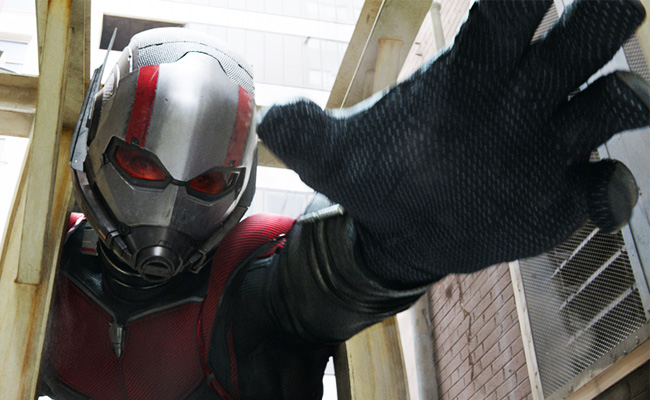
It feels like a snooty thing to say, but in order to be truly successful, Ant-Man and the Wasp has to be about more than an Ant Man and a Wasp. That’s not to say I’m above enjoying a movie about an Ant-Man who can shrink and enlarge himself at will — I’m absolutely not — and in fact the scale-altering special effects of Ant-Man’s shrinky dink button (not sure if this is the official name) are some of the best in the Marvel Universe. What I mean is simply that to be fully invested in this story, someone needs to bring something personal to it.
Director Peyton Reed, along with stars Paul Rudd, Evangeline Lilly, Michael Douglas, Michelle Pfeiffer, Michael Peña, Randall Park… (and more!) bring a high level of craft and considerable charm to the proceedings. The jokes are solid, the cast is wonderful, and the action zooms along pleasantly. I’m just not quite sure what this movie is about. It’s funny enough. And it’s pleasantly weird, though not as pleasantly weird as Guardians of the Galaxy, or even Doctor Strange. What exactly is Ant-Man’s place in this wider universe, anyway?
Ant-Man‘s obvious counterexample, Black Panther, saw Ryan Coogler and Joe Robert Cole struggling with black identity and subverting ideas about geographical determinism. I don’t expect that heady a subtext in a superhero movie every time out, but even the otherwise bloated and overlong Infinity War had a riff on population control and protecting the few at the expense of the many. And thus was in some small way about fascism, capitalism, eugenics.
Ant-Man and The Wasp isn’t nearly so bloated, or even bloated at all, really, which is nice, and the stakes are refreshingly low, which is also nice. A superhero movie doesn’t have to be, nor should it be, boiled down to an “ism.” But it does have to feel like it contains some idea or wisp of a feeling that someone somewhere struggled with, and I’m not sure Ant-Man and The Wasp does.
The story sees Scott Lang (Paul Rudd) cooped up on house arrest on orders of the US government, explained charmingly by an FBI agent played by Randall Park, where the convoluted legalities are the butt of the joke (Randall Park: still very good). So Scott spends his days with an ankle bracelet, cooking up Wes Anderson-esque mazes for his daughter and learning card tricks online (which becomes a recurring joke; a good one). One thing Ant-Man never really reckons with is why superheroes bother obeying a government that clearly can’t control them. Is it out of patriotism? Convenience? What is at issue here?
Anyway, Hank Pym (Michael Douglas) and his daughter, Hope (Evangeline Lilly), Scott’s ex-flame, are still on the run, trying to cook up a bigger, fancier shrinky dink ray to go fully quantum, and hopefully find Hank’s wife/Hope’s mom, played by Michelle Pfeiffer, who’s been lost in the subatomic ether for 20 years since going quantum to stop a runaway ICBM. And they need something Scott has in his head to find her because of… uh… something called “quantum entanglement.”
Honestly, the whole plot makes very little sense, but it’s explained charmingly and tongue-in-cheekily enough that you wouldn’t mind, if only it felt like it was about something. Doctor Strange was just as nonsensical, but beneath the surface contained a pretty profound riff on mortality. Black Panther had plenty of plot holes and hare-brained storytelling too, complete with multiple scenes set in African heaven. But in Black Panther they were stand-ins for bigger ideas, whereas in Ant-Man and The Wasp, they just… aren’t.
There are two sorta-kinda villains, Walton Goggins’ Sonny Burch, an evil tech titan who wants to use quantum shrinky dink rays for fun and profit, which is bad, or so we’re led to believe by his constant sneering — and Hannah John-Kamen’s Ava, a trained assassin who can teleport, thanks to her molecules that are torn apart at the subatomic level, which also leaves her in constant pain. The comic book take on Ava’s subatomic fibromyalgia is interesting, and her motivations (to not hurt anymore) are simple and straightforward. Also, there are some cool teleporting effects.
The part that’s harder to understand is why Ava’s goals and Scott/Hank/Hope’s goals are in conflict. There’s some more convoluted mumbo-jumbo about quantum gobbledygook to try to explain, which would be fine for a setup, but you can’t yadda yadda a central conflict. It feels easily resolved, and ultimately is, and so we’re never entirely invested. It makes the finale feel less like a white knuckle thrill ride than passively watching characters run from place to place.
Ant-Man and The Wasp is an improvement over its predecessor in a lot of ways, namely, in humor that actually works. It has charming actors, exciting action, and cool special effects, but it never quite adds up to the sum of its parts. Its main challenge was to justify Ant-Man‘s place in a crowded superhero slate, and I’m not sure it does. Ant-Man needs to be a conduit for some big ideas, and for all Paul Rudd’s charm they’re still lacking.






